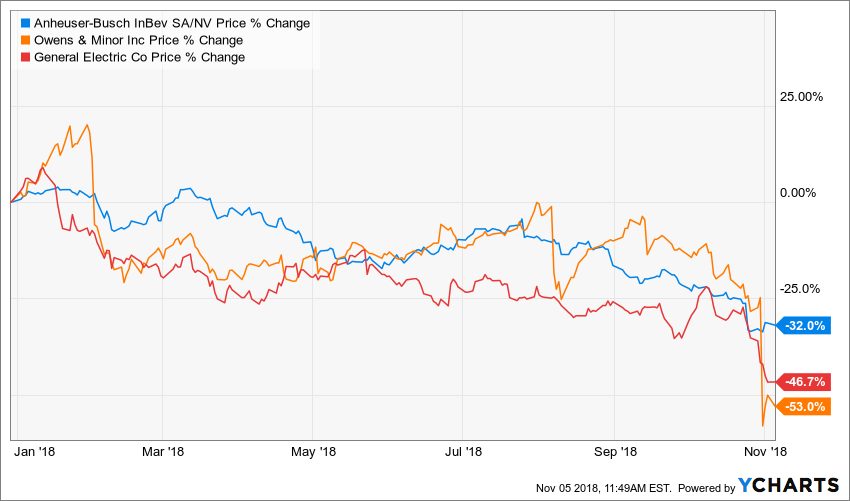- All three are well-known giants in their industry.
- All three were offering a relatively high yield.
- All three were praised by dividend investors.
- All three failed their shareholders.
- All three were never considered for my dividend growth portfolio.
We are right in the middle of the earnings season and fall have brought us some horror stories right around Halloween. While over 75% of the S&P 500 companies have beat EPS and over 60% did the same thing for revenue expectations, there are some great companies which cut their dividend and failed their shareholders. Why do I use the term “great”, because when you read their “company’s description”, you would be tempted to pick them for your portfolio.

A tale of three giants which failed their shareholders
General Electric (GE) is a 100-year-old company offering various digital industrial products. Over the past few years, the company has realigned all its business segments toward powering the industrial internet with its software experience. GE is currently going through a major transformation as it became “too big” to be managed. Throughout this transformation, GE performed a second dividend cut in two years. If you are a shareholder, you will now receive $0.01 per share. GE is definitely not part of our top dividend industrials list.
Owens & Minor (OMI) is a healthcare company involved in the transportation/distribution of healthcare products, along with data management and analytics. It is mainly active on U.S. soil with not much international exposure. OMI is divided into two segments, global solutions, and global products, with global solutions representing 86% of revenue. OMI is pretty much in the middle of large medical suppliers – such as Johnson & Johnson (JNJ), Medtronic (MDT), and Becton, Dickinson, and Company (BD) – and customers such as hospitals and group purchasing organizations (GPO). As the company was getting pressured by a competitive environment, management cut its dividend from $0.26 to $0.075.
ANHEUSER-BUSCH INBEV (BUD) dominates the beer market with 18 brands selling over $1 billion per year. The company is a great example of a strong dividend payer in the consumer defensive industry. Brands such as Budweiser (BUD shows 48% of US market share), Stella Artois (Belgium) and Corona are well known across the world. For the record, my own favorite beer is Hoegaarden. Unfortunately, their dividend is not as tasty as the “Hou” as I like to call my favorite drink. BUD slashed its dividend by 50% in November.
Did you see that coming?
Ah! I wish I would tell you that I’m that kind of genius. That I’m so great that when I look at the stock market, I can predict which company will cut their dividend while others will increase their payouts. Unfortunately, I’m just a mortal (pretty much like you), but those three companies never made it on my radar.
I wrote an article about GE back in February 2017. The title was “Get Rid Of GE Before It Fails You Again”. And I followed-up in October with “General Electric: Can You Handle Another Dividend Cut?”. In this case, I got lucky and I was spot on… The company has always been rated as a “sell” at Dividend Stocks Rock.
In April 2018, I looked at Owens & Minor and concluded it was “dead money”. However, I didn’t expect a dividend cut. I thought the company could manage a 1-3% dividend growth policy while it navigates through shallow waters. I ended-up my analysis with the following:
“It’s always tempting to pick shares of a large company offering a 6%+ yield, I get that. However, I think you should stop focusing on OMI dividend history and yield and get back down to earth; this is dead money. This stock is just not healthy for your portfolio (ah!).”
OMI was also rated as “sell” at Dividend Stocks Rock.
Finally, I didn’t really like BUD in early 2018, but it was more because I didn’t like its dividend growth perspective going forward.
“At this point, I still consider BUD as a dividend paying stock, but I don’t put too much fate into future dividend growth perspectives.”
BUD was a dividend achiever until October. It was rated as a “hold” at Dividend Stocks Rock.
Right after I finish writing this article, I noticed another dividend cut coming from Buckeye Partners LB (BPL). Buckeye Partners LP is a US-based company which owns and operates a diversified network of integrated assets providing midstream logistic solutions, consisting of the transportation, storage, and marketing of liquid petroleum products. It gets about 50% of its revenue from gasoline and 25% each from jet fuel and distillates. BPL slashed its dividend by 50% last Friday.
In July, I reviewed BPL at DSR and wrote the following:
“At DSR, we get suspicious about any companies showing a yield higher than 6% (sometimes 5%!). While this doesn’t mean those companies are automatic sell, when the dividend reaches double-digits, now it’s time to pull the red flag. BLP’s dividend yield is too generous and there is a reason for it: the current cash flow doesn’t support its payout. Therefore, the company will need to rapidly address its challenging conditions, or the dividend will have to be reduced. We don’t think issuing more units will answer all the questions.”
Well, finally, I got lucky twice in the past few months. I guess there is nothing replacing a strong investment thesis, isn’t?
3 companies, three analysis, one verdict
As you can see, even if I didn’t like all three companies, I was only convinced of a dividend cut for GE. This also reflects the perception of the market. By looking at how all three company shares tumbled in 2018, there were very few to predict this abyss:

Source: Ycharts
The truth is that most dividend cuts will happen as a surprise. Nobody can really predict them. Management will wait until the last second to use this extreme solution. A dividend cut sends a terrible message to the market and the stock always pay the price.
Here are a few tricks to avoid dividend cuts
A dividend cut announcement is definitely the worst news you can get as a dividend investor. It reduces your immediate source of income (the dividend) and it amputates a good part of your portfolio value. You want to avoid them at all cost.
My investing platform, Dividend Stocks Rock, will shortly celebrate 5 years of existence. I’m proud that none of our holdings have suffered a dividend cut in 5 years and only a handful of them missed increasing their payouts each year. In October 2018, we hosted a free webinar explaining our methodology to avoid dividend cuts (you can watch the replay for free here).
We make sure each company we keep in our portfolios show the following characteristics:
- #1 They are dividend growers
- #2 They show growth vectors
- #3 They show reasonable payout ratio (cash payout ratio or AFFO payout ratio)
- #4 They don’t pay a high yield (or we get very cautious)
If you want to learn more about those characteristics and how I look at them, you can read my quick guide to avoiding dividend cuts.
In the end, it is very hard to not be surprised by dividend cuts. I always prefer to remain cautious and never invest more than 20-25% of my portfolio in a single sector. Therefore, if I ever get “caught” by a “cut”, it will hurt only a part of my portfolio and not most of my holdings. Because when things start to get sour in an industry, it gets ugly for everyone…
disclaimer: I don’t own (and never considered) OMI, BUD, BPL or GE.
The post What GE, Owens & Minor and Budweiser have in common? appeared first on The Dividend Guy Blog.
